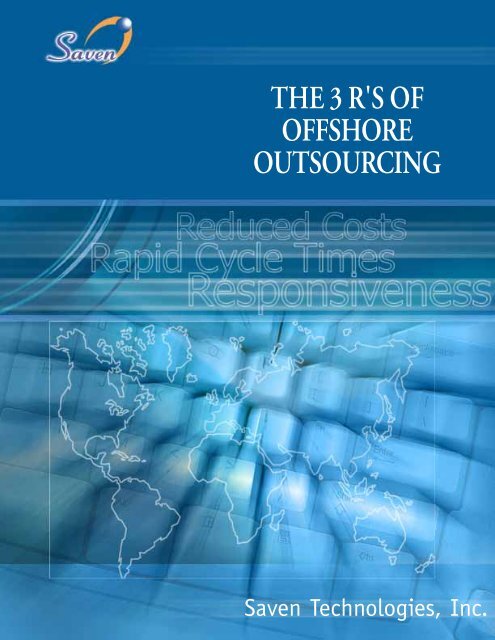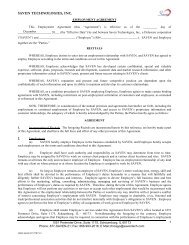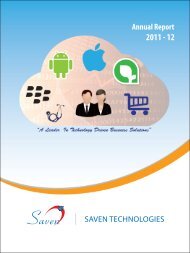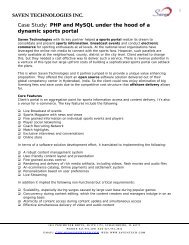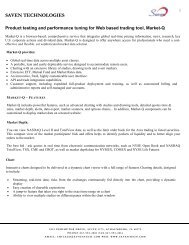THE 3 R'S OF OFFSHORE OUTSOURCING - CiteSeerX
THE 3 R'S OF OFFSHORE OUTSOURCING - CiteSeerX
THE 3 R'S OF OFFSHORE OUTSOURCING - CiteSeerX
- No tags were found...
Create successful ePaper yourself
Turn your PDF publications into a flip-book with our unique Google optimized e-Paper software.
Table of ContentsIntroduction 3Outsourcing: Business Rationale 5Outsourcing Best Practices: Doing it Right 8Measuring the Returns: The Three R's 9About Saven Technologies 11About the Author 11References 11Copyright 2001 Saven Technologies.http://www.saventech.com2
IntroductionOutsourcing expenditure worldwide topped $ 1 trillion in 2000 according to a Dun &Bradstreet study, with the US contribution at $ 318 million. Companies are trying toreduce costs and maintain quality at the same time which, in an era of rapid technologicalchange and short product life cycles, implies that companies need to specialize in whatthey do best and de-emphasize management attention from business processes that donot directly impact the business. Outsourcing is a means to partner with service providersso they can handle specific business processes - better, faster and at a lower operatingcost.Figure 1 shows the results from a survey regarding which business processes are generallyoutsourced. The dominant operation is Information Technology.Human ResourcesFinance & AccountingCustomer ContactInformation TechnologyReal Estate/Facilities ManagementSupply Chain/ProcurementLogistics19%14%7%8%6%10%36%Source: Outsourcing CenterFigure 1: Business processes significantly outsourced by organizations.The reasons for this are several-fold:q Information technology is rapidly changing. An organization for which IT isnot the core business may find itself unable to rapidly adapt to newtechnologies.q In addition to the time lag, the effort and expense required for training and/or recruiting qualified personnel places demands on IT management as well asother operations such as the human resources department.Copyright 2001 Saven Technologies.http://www.saventech.com3
Outsourcing: Business RationaleThe top reasons cited by companies for choosing outsourcing are summarized in Figure 3below.Cutting operating costs29%Avoiding needed investment13%Focusing on core business29%Inability to staff appropriatelyUpgrading to current service levels14%14%Figure 3: Reasons for outsourcing by organizations.Source: Outsourcing CenterThe next two sections illustrate how companies can realize operational efficiencies andcompetitive advantages from offshore outsourcing.Operational EfficiencyOperational efficiencies can result not only from reducing costs but also from improvingthe performance of existing people and resources. Table 1 illustrates how offshoreoutsourcing helps reduce operating costs (Scenario I). Typical cost savings of 50% arepossible with offshore outsourcing which directly flow to operating profit.Scenario II assumes a 5% growth in revenue realized with the existing personnel focusingmore on business management and development issues rather than operational issues.This increased focus - even better communication between the business and technicalunits - results in an organization that responds and reacts faster to marketplace dynamics.Copyright 2001 Saven Technologies.http://www.saventech.com5
Table 1: Operational efficiency from outsourcing reflects in both toplineand bottom-line growth.Item Before After OutsourcingScenario I Scenario IIRevenue 100 100 105Cost of Revenue 40 40 42Gross Profit 60 60 63General & Administrative 20 20 20Sales & Marketing 10 10 10Product Development 10 5 5Technical Operations 10 5 5Operating Profit 10 20 23Growth + 100% + 130%It should be noted that organizational resistance is the single biggest impediment tooutsourcing, not only because of skepticism about whether it can work but also due tothe resulting uncertainty and the added perception that outsourcing leads to job loss.When done right, outsourcing results in little or no job loss. To be sure, changes arerequired in the ranks of the technical personnel who can either be transferred to theoutsourcing company or need to be replaced, most likely due to the company's technologyadoption initiatives where some skills become obsolete.Middle management has several years of accumulated business expertise and has operationaloversight responsibility even after outsourcing. Since they no longer have to deal withday-to-day technical issues at a detailed level, it frees up time to interact with businessunits as well as analyze how the increased technical resources can be used to impactbusiness positively.Outsourcing in the best sense allows companies to operate at a higher level of revenuewithout having to see a corresponding increase in operating costs.Copyright 2001 Saven Technologies.http://www.saventech.com6
Competitive AdvantageOutsourcing allows a company to bring products to market faster in addition to maintainingdevelopment costs within budget.Table 2: Projected profits for new products in their first five years undervarious time and budget scenarios [2] .Time andBudget MatrixOn BudgetBUDGETOver BudgetTIMEOn TimeOver Time100% 96%67% POTENTIAL FAILURETable 2 shows the interplay between time and budget. A key point to note is thatkeeping a project on time is probably more crucial to the eventual success of the projectand its return on investment rather than keeping it within budget. Since the impact of aproject running over budget is easier to quantify than the business impact of implementingit on time, management attention disproportionately focuses on budgets whereasreducing product development times has a far greater impact on the eventual success ofthe project.Outsourcing allows the company to maintain a perspective between time and budget.Reducing both time and budget are possible with outsourcing – especially offshoreoutsourcing to countries such as India. In addition to the cost differential, the timedifferential is another critical factor in such cases. In the US, a manager can typicallyevaluate a project and suggest changes during the day. The request is received by theoffshore team at the end of the day US time (start of the day in India) and implementsthe changes. When the US manager returns to work the next morning, the suggestedchanges are incorporated in the development process and the result is again available forreview. A 24x7 development cycle technically halves the time in which the companyusually brings products to market.Copyright 2001 Saven Technologies.http://www.saventech.com7
Outsourcing Best Practices: Doing it RightSelecting a PartnerSelecting a partner that can provide the cost savings as well as the required level ofservice is crucial to the success of the outsourcing effort. Since outsourcing contractsare long-term, selecting the wrong partner can result in increased costs associated withpoor response times and inability to deliver.Figure 4 illustrate the factors that drive the choice of the outsourcing partner. Companiesdriven solely by cost considerations may find out that the level of service and responsivenessof the partner is not acceptable but the cost of switching is so prohibitive that thecompany is forced to accept an inferior level of service for the duration of the contract.Any efficiencies that the company expects to realize fail to materialize as a result.Geographic location4%Level of service25%Technology innovationEmployee retentionDirect cost savingsOverall business impact3%7%23%37%Source: Outsourcing CenterFigure 4: Benefits companies look for while selecting an outsourcingprovider.With offshore outsourcing, the company should ensure that the partner has a significantUS presence as well, to maintain an effective channel of communication. Further, anonsite team from the outsourcing partner should be present to liaison between thecompany management and the offshore team.Operational AnalysisThe company should conduct a study - either internally or with a potential partner - toidentify the activities best suited for outsourcing as well as the phases in which theresponsibilities transfer should occur. Typically, repetitive and pure technical functionssuch as help desk management, systems and database administration are best suited forpreliminary transition. This can be followed by application development and maintenancewhich require domain knowledge in addition to technical skills. For application developmentwork, a higher level of interaction is also required between company management andthe outsourcing partner to ensure project deadlines are met effectively.Copyright 2001 Saven Technologies.http://www.saventech.com8
Measuring the Returns: The Three R’sSetting up and monitoring the performance metrics on an ongoing basis helps companiesmeasure and continuously improve the benefits from outsourcing. The three criticalfactors that require measurement and monitoring are Reduced Costs, Rapid Cycle Timesand Responsiveness.Reduced CostsCompanies should expect to realize cost savings starting in the first three months of anoutsourcing relationship. In offshore outsourcing, the rates should be monitored whilefactoring in productivity. Price quotes that are half of what the company is payingcurrently have little meaning when it takes three people to do the work of one. Costsadjusted for productivity need to be measured.Rapid Cycle TimesCompanies should see substantial reduction in the time it takes to implement newproject initiatives. Taken together with the reduced costs, this is where the companiesrealize the real synergy of an outsourcing partner. Reduced costs with a rapidimplementation time enhances the viability of new projects by providing a much moreattractive cost-to-benefit ratio.ResponsivenessThe outsourcing company must have a pre-existing and proven process for interactingwith the company management on a regular basis and responding to requests. Reducedcosts and rapid cycle times will not be realized without a rapid response time from theoutsourcing partner. Imagine a scenario where a critical database has gone down or aproject manager finds out at the last minute that the development work is way off themark relative to the requirements. Without an ongoing, constant, consistent and measurableprocess with checks and balances for responsiveness, the outsourcing relationship is setfor failure.“The success of anoutsourcing partnership willdepend on three things:People, Process and Price,in that order.”Copyright 2001 Saven Technologies.http://www.saventech.com9
The India FactorIn a now famous article, Krugman [3] hypothesized that the growth of developing Asiannations was mostly due to perspiration - the movement of underemployed peasants intothe modern sector, among other factors - than due to inspiration - any productivitygains from innovation. Krugman further clarifies [4] , "So the perspiration theory suggestedthat sooner or later Asia's growth would slow down - sooner in the case of the originalAsian tigers like Singapore, which is already investing half its GDP; later in low-wagecountries like China that still have vast reserves of underemployed rural labor to exploit."(Labor costs,includingstatutory costs suchas taxes and insurance,cost markups, and costrisks associated witha particular country)HighCostLown Hungaryn MalaysiaPhilippines nChina nLowMexico nRussiaHighQuality of supply(Resource avalability; CMM * level; cultural fit)* The capability maturity model (CMM) is a metric developed bythe Software Engineering Institute to specify the level of processmaturity associated with a software organization.India provides a viable exception to this hypothesis mostly because 1 the driver forgrowth is information technology, which does not require massive infrastructureinvestments as required for manufacturing and 2 the labor available is self-generatedon a regular basis rather than transferred from the rural to the industrial sector. A legacyof the British rule, India is one of the largest English speaking nations and has aneducational system in science and engineering that has been a constant priority for theGovernment since independence.To companies considering offshore outsourcing, this translates into two things:q India offers a sustainable competitive advantage in terms of qualified talent andq Operational efficiencies realized can be maintained over the long-term.nIreland n Israel nn SingaporeIndia n“Only in India does the production ofuniversity graduates outpace the economy.India generates more university graduates than theUnited States- some 40% with degrees in[1]science and engineering.”Source: The McKinsey Quarterly, 2001 Number 2Copyright 2001 Saven Technologies.http://www.saventech.com10
About Saven TechnologiesSaven Technologies is an Information Technology Services Provider that specializes in planning,managing and implementing Information Technology solutions. Through offices in USA, UKand India, Saven offers consulting services on an onsite, offsite and offshore basis. Savenalso develops products complementary to its consulting operations that further add immediate,measurable value to clients. Our approach is to apply a structured delivery methodologybased on industry best practices, providing end results with significant business benefits.Our focus is to deliver custom solutions for financial industry. As a pioneer in innovativesolutions and technologies, the company has vast experience in a broad spectrum of missioncriticalofferings that include B2B and B2C financial enterprise integration, electronic trading,finance portal, market data and exchange automation solutions. The company’s solutionsenable financial services clients to deploy real-time event-driven e-Business applicationsthat enable them to respond to rapidly changing markets and business events anywhere inthe world. Our consulting services enjoy the challenge of building state-of-the-art systemsand have proven, over-and-over, their ability to deliver.Further information on Saven Technologies may be found at: www.saventech.comContact Info: Sridhar Chelikani6250 N. River Road, Suite 6010Rosemont, IL 60018Ph: 877-SAVEN 21 x 204eMail: schelikani@saventech.comAbout the Authors1. Sridhar Chelikani is the President of Saven Technologies. Prior to Saven, Sridhar worked incommodities industry viz. MC Baldwin Financial, Chicago Mercantile Exchange. Sridhar holdsan MBA in Finance from the University of Illinois at Urbana Champaign, an MS in MechanicalEngineering from Indian Institute of Sciences, Bangalore, India and a B. Tech. in MechanicalEngineering from Jawaharlal Nehru Tech University, Hyderabad, India.2. V. Krishna Polineni is the President and CEO of Serebrum Corporation. Prior to Serebrum,Krishna was engaged in research at Pfizer, Inc and he translates the same disciplined rigor toclient engagements and product development activities. Krishna holds an MBA in Financeand International Business from the Stern School of Business, New York University, an MS inMechanical Engineering from Iowa State University and a B. Tech. in Mechanical Engineeringfrom Jawaharlal Nehru Tech University, Hyderabad, India.References[1] Naisbitt, John, Megatrends Asia: Eight Asian Megatrends That Are Reshaping Our World, Simon& Schuster, 1996.[2] Kotler, Philip, Marketing Management: Analysis, Planning, Implementation and Control,Prentice-Hall, 1997.[3] Krugman, Paul, The Myth of Asia's Miracle, Foreign Affairs, 73, 6, Nov/Dec, 1994, 62 77.[4] Krugman, Paul, What Ever Happened To The Asian Miracle?, Fortune, August 18, 1997.Copyright 2001 Saven Technologies.http://www.saventech.com11


